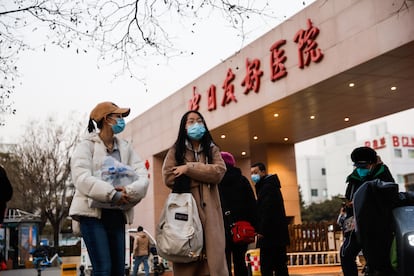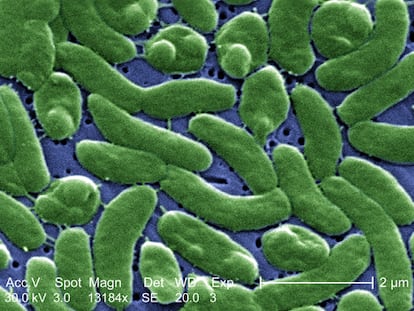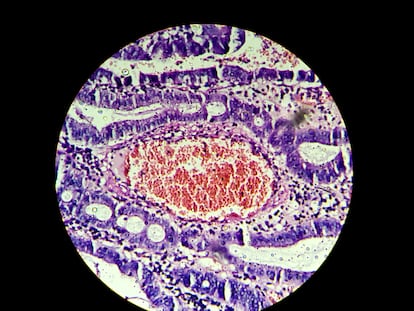‘Mycoplasma’: The peculiar bacteria that has the WHO on alert
Health authorities are encouraging countries to strengthen surveillance systems and to report any changes in the incidence or severity of detected cases

The aftershocks of the Covid-19 pandemic continue to stir up the universe of viruses and bacteria that can make humans sick. The lockdown rules and the use of masks imposed to stop the spread of the coronavirus also kept down the infections of other pathogens, which now — with all restrictions lifted — are recovering lost ground. These pathogens are also finding greater opportunities to spread due to the decline in the population’s natural immunization, which under normal conditions occurs imperceptibly.
If last winter, it was the respiratory syncytial virus that hit Europe and pushed pediatric hospital wards to the limit, now it is mycoplasma pneumoniae that is causing concern among international health authorities. Also known as Eaton agent — after the American researcher Monroe A. Eaton who isolated it for the first time in 1944 — the bacterium is being closely monitored by the World Health Organization (WHO), which was the first to report on the significant rise in pneumonia cases in China a little over a month ago. And now it is the European Centre for Disease Control and Prevention (ECDC) that has been monitoring the increased circulation of mycoplasma in Europe, with a spike in infections reported by six countries: France, the Netherlands, Ireland, Denmark, Sweden and Norway.
Mycoplasma is a “very peculiar” bacteria for several reasons, experts explain. Like amoebas, “it does not have a cell wall, which allows it to deform and infiltrate the body’s natural defense barriers more easily. Furthermore, this makes it immune to some antibiotics such as penicillins, which act on this wall,” says Pere-Joan Cardona, head of the Microbiology service at the Germans Trias Hospital in Badalona, Spain.
Carlos Rodrigo, a member of the Spanish Society of Pediatric Infectology (SEIP), explains that this pathogen “behaves halfway between viruses and bacteria” in clinical manifestations. “Like most viruses, it does not usually cause very serious symptoms. But in some circumstances, it is capable of colonizing the lower respiratory tract like other bacteria and causing pneumonia and other complications. In this case, unlike viruses, we do have a treatment, which is antibiotics such as macrolides [azithromycin, erythromycin...]. But in the vast majority of cases, the symptoms are self-limiting. They are moderate symptoms that last for a few days and do not require antibiotics,” he says.
The fact that mycoplasma is less virulent compared to other bacteria that affect the respiratory tract has led to another striking situation. “It is a pathogen that has been among us all our lives, but we still don’t know much about it. In large part, this is because, as it produces mostly mild symptoms and, in practice, is indistinguishable from many respiratory viral infections, we often did not go much further when investigating cases,” Rodrigo explains.
“The bacteria can colonize the pharynx asymptomatically. Up to 20% of the population has it without suffering any problems until some factor such as cold, or a viral infection creates the conditions that facilitate its descent into the lungs. That’s why it is not surprising that countries in northern Europe or areas of China with a similar climate have detected this increase in infections first,” adds Cardona.
Two factors related to the pandemic have contributed to the current global surge in mycoplasma infections and serious cases. “It is a bacterium that usually presents cycles, and registers a peak of cases every two or three years. With each peak, the natural immunization of the population increases, and this causes the incidence to be lower in the following ones. With the pandemic restrictions, its circulation decreased greatly and the susceptible population with little immunity has grown a lot. The logical result is that now there is an increase in the number of infections,” summarizes Pere Godoy, a member of the Surveillance Working Group of the Spanish Society of Epidemiology (SEE).
The immunity developed after an infection by the bacteria is not long-lasting, and a person can suffer respiratory conditions from mycoplasma several times in their lifetime. This also explains why the more time has passed since the previous infection, the more susceptible a person is to contracting it and developing more severe symptoms. The most affected population groups are usually children from the age of four or five and adolescents. “Public health services often detect outbreaks in schools or other institutions frequented by children of these ages,” explains Godoy.
According to the experts, the second reason behind the current rise in cases has to with the improved diagnostic capacity of health systems following the pandemic. “Before, a respiratory infection was diagnosed and, if it was not serious or did not produce a serious outbreak, it was not investigated. Mycoplasma is not a notifiable disease. But now we have PCR tests in most hospitals. Families and health professionals have become accustomed to knowing the cause of infections. Much more is analyzed, and the results allow us to identify pathogens that were previously undetermined,” Rodrigo maintains.
Experts hope this change will allow scientists to learn details about this pathogen that were previously unknown. One of the mysteries, says Rodrigo, is why younger children do not usually suffer significant clinical symptoms due to the bacteria.
In a recent threat report, the ECDC warned of the situation in countries such as the Netherlands, where diagnoses are “reaching higher levels compared with the last four years” and leading to a rise in “pneumonia in patients aged five to 14.”
In the six countries that have reported a rise in mycoplasma infections, the increases have been reported “in all age groups but are predominantly observed in children and adolescents.” The report added: ”One country observed an increase in severe cases admitted to the intensive care unit.”
So far, no country has observed an increase in resistance of this bacterium to macrolide antibiotics. The ECDC is encouraging countries to strengthen surveillance systems and to report any changes in the incidence or severity of detected cases.
Sign up for our weekly newsletter to get more English-language news coverage from EL PAÍS USA Edition
Tu suscripción se está usando en otro dispositivo
¿Quieres añadir otro usuario a tu suscripción?
Si continúas leyendo en este dispositivo, no se podrá leer en el otro.
FlechaTu suscripción se está usando en otro dispositivo y solo puedes acceder a EL PAÍS desde un dispositivo a la vez.
Si quieres compartir tu cuenta, cambia tu suscripción a la modalidad Premium, así podrás añadir otro usuario. Cada uno accederá con su propia cuenta de email, lo que os permitirá personalizar vuestra experiencia en EL PAÍS.
¿Tienes una suscripción de empresa? Accede aquí para contratar más cuentas.
En el caso de no saber quién está usando tu cuenta, te recomendamos cambiar tu contraseña aquí.
Si decides continuar compartiendo tu cuenta, este mensaje se mostrará en tu dispositivo y en el de la otra persona que está usando tu cuenta de forma indefinida, afectando a tu experiencia de lectura. Puedes consultar aquí los términos y condiciones de la suscripción digital.
More information
Archived In
Últimas noticias
Chris Martin, Taylor Swift, Elijah Wood and other famous wedding ‘crashers’
‘How does it feel to be a failure?’: Elizabeth Berkley’s journey from ‘Showgirls’ ridicule to vindication
The story of the Málaga virus: The code that haunted Google’s cybersecurity center director for 30 years
The impact of Ecuador’s mega-prison: A polluted river, cleared forests and military checkpoints
Most viewed
- Christian Louboutin: ‘Young people don’t want to be like their parents. And if their parents wear sneakers, they’re going to look for something else’
- The low-cost creative revolution: How technology is making art accessible to everyone
- Liset Menéndez de la Prida, neuroscientist: ‘It’s not normal to constantly seek pleasure; it’s important to be bored, to be calm’
- All the effects of gentrification in one corner of Mexico’s Colonia Roma
- December Social Security and SSI payments: Dates, double checks and the 2026 COLA increase











































